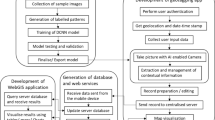Abstract
In the process of monitoring the gymnasium by the traditional radio frequency technology, the parallel computing problem of the large data environment in the gymnasium monitoring cannot be handled effectively. It cannot be identified independently and accurately, and the gymnasium monitoring algorithm based on large data is proposed. In the process of Map-Reduce parallel monitoring based on AE, off-line training of monitoring image recognition model based on AE and neural network is carried out. Through the weighted fusion algorithm of trajectory correction, the best data fusion result is obtained, and the offline training recognition model is used to identify the image information. In parallel monitoring, if there is a correlation between the monitoring events, the Map function is used to read the test sample data, and the mapping of the corresponding key values is obtained. The mapping records generated by the Map function are performed by the Reduce function to obtain the monitoring and identification results of the gymnasium. The experimental results show that the proposed algorithm can accurately and efficiently identify the monitoring images of the gymnasium.





Similar content being viewed by others
Change history
13 September 2022
This article has been retracted. Please see the Retraction Notice for more detail: https://doi.org/10.1007/s11042-022-13869-x
References
Biswas SS, Srivastava AK, Whitehead D (2015) A real-time data-driven algorithm for health diagnosis and prognosis of a circuit breaker trip assembly. IEEE Trans Ind Electron 62(6):3822–3831
Chaouch N, Temimi M, Romanov P et al (2014) An automated algorithm for river ice monitoring over the Susquehanna River using the MODIS data. Hydrol Process 28(1):62–73
Chaudhry SA, Albeshri A, Xiong N et al (2017) A privacy preserving authentication scheme for roaming in ubiquitous networks. Clust Comput 20(2):1–14
Czaplewski RL (2015) Novel Kalman Filter Algorithm for Statistical Monitoring of Extensive Landscapes with Synoptic Sensor Data. Sensors 15(9):23589–23617
Fan Q, Xiong N, Zeitouni K et al (2016) Game balanced multi-factor multicast routing in sensor grid networks. Inf Sci 367(C):550–572
Lin B, Guo W, Xiong N et al (2016) A Pretreatment Workflow Scheduling Approach for Big Data Applications in Multicloud Environments. IEEE Transactions on Network & Service Management 13(3):581–594
Ma Q-f, Xiao L-q (2015) An on-line monitoring algorithm for annular two phase flow. Computer Simulation 32(8):439–443
Malik OA, Senanayake SMNA, Zaheer D (2015) A Multisensor Integration-Based Complementary Tool for Monitoring Recovery Progress of Anterior Cruciate Ligament-Reconstructed Subjects. IEEE/ASME Transactions on Mechatronics 20(5):2328–2339
Martins N, Caetano E, Diord S et al (2014) Dynamic monitoring of a stadium suspension roof: Wind and temperature influence on modal parameters and structural response. Eng Struct 59(2):80–94
Matthews MW, Odermatt D (2015) Improved algorithm for routine monitoring of cyanobacteria and eutrophication in inland and near-coastal waters. Remote Sens Environ 156(156):374–382
Nabavi S, Zhang J, Chakrabortty A (2015) Distributed Optimization Algorithms for Wide-Area Oscillation Monitoring in Power Systems Using Interregional PMU-PDC Architectures. IEEE Transactions on Smart Grid 6(5):2529–2538
Peng HX, Zhao H, Li DZ et al (2014) Research on Reliability-Oriented Data Fusaggregation Algorithm in Large-Scale Probabilistic Wireless Sensor Networks. International Journal of Distributed Sensor Networks 2014(93):1–11
Sapundjiev D, Nemry M, Stankov S et al (2014) Data reduction and correction algorithm for digital real-time processing of cosmic ray measurements: NM64 monitoring at Dourbes. Adv Space Res 53(1):71–76
Siegel D, Zhao W, Lapira E et al (2014) A comparative study on vibration-based condition monitoring algorithms for wind turbine drive trains. Wind Energy 17(5):695–714
Toté C, Patricio D, Boogaard H et al (2015) Evaluation of Satellite Rainfall Estimates for Drought and Flood Monitoring in Mozambique. Remote Sens 7(2):1758–1776
Vinel A, Chen WSE, Xiong NN et al (2016) Enabling wireless communication and networking technologies for the internet of things [Guest editorial]. IEEE Wirel Commun 23(5):8–9
Xu S, Xiong W, Yang T et al (2016) General Social Network Relation about Emotional Intelligence to Job Performance. Journal of Internet Technology 17(6):1151–1160
Yang D, Zhang H, Liu Y et al (2017) Monitoring Carbon Dioxide from Space:Retrieval Algorithm and Flux Inversion Based on GOSAT Data and Using CarbonTracker-China. Adv Atmos Sci 34(8):965–976
Zheng H, Guo W, Xiong N (2017) A Kernel-Based Compressive Sensing Approach for Mobile Data Gathering in Wireless Sensor Network Systems. IEEE Transactions on Systems Man & Cybernetics Systems PP(99):1–13
Zhou C, Huang X, Xiong N et al (2017) A class of general transient faults propagation analysis for networked control systems. IEEE Transactions on Systems Man & Cybernetics Systems 45(4):647–661
Acknowledgements
This work was supported by Guangdong Provincial Key Laboratory of Technology and Finance & Big Data Analysis (Grant No.2017B030301010); Platform of Credit Financing and Trade for Guangdong Technological Enterprises (Grant No.2014B080807035); Construction of New Technology Credit Service Platform Based on O2O Mode (Grant No.2017B080802004); Guangdong Key Research Base of Technology and Finance (Grant No.2014B030303005); Guangdong Technology & Finance Information Service Platform (Grant No.2015B080807015).
Author information
Authors and Affiliations
Corresponding author
Additional information
Publisher’s Note
Springer Nature remains neutral with regard to jurisdictional claims in published maps and institutional affiliations.
This article has been retracted. Please see the retraction notice for more detail: https://doi.org/10.1007/s11042-022-13869-x
Rights and permissions
Springer Nature or its licensor holds exclusive rights to this article under a publishing agreement with the author(s) or other rightsholder(s); author self-archiving of the accepted manuscript version of this article is solely governed by the terms of such publishing agreement and applicable law.
About this article
Cite this article
Han, K., Xiao, G. & Yang, X. RETRACTED ARTICLE: An effective stadium monitoring control algorithm based on big data in emerging mobile networks. Multimed Tools Appl 78, 29971–29987 (2019). https://doi.org/10.1007/s11042-018-6688-8
Received:
Revised:
Accepted:
Published:
Issue Date:
DOI: https://doi.org/10.1007/s11042-018-6688-8




